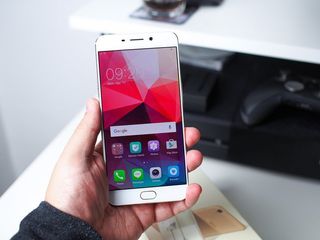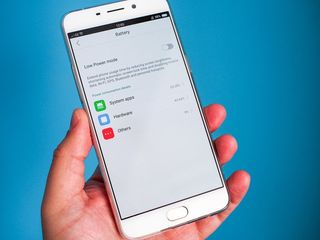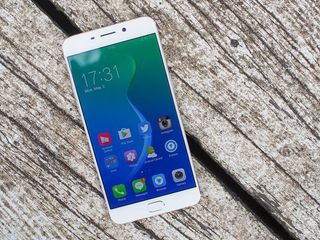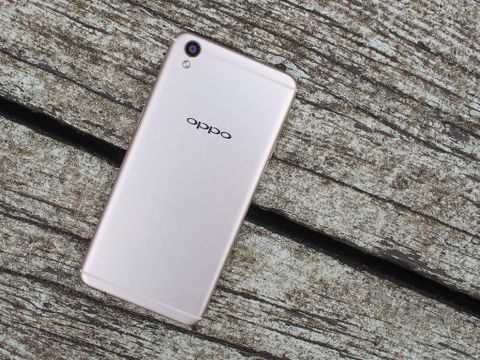The quick take
Oppo is a name still alien to the smartphone masses in the West, but that hasn't stopped it from working hard in the East. It's been steadily putting out better and better phones in the last year or so, culminating in the F1 Plus — its best yet. It looks a bit too much like an iPhone for some tastes, and the software is a big departure from the Android many know and love. But there have been so many steps forward it's hard not to be impressed. If only it wasn't running Lollipop.
Pros
- 64GB internal storage as standard
- Excellent build quality
- One of the fastest fingerprint sensors around
Cons
- Uninspired design
- Color OS still has some flaws
- Still on Lollipop
The selfie expert
Oppo F1 Plus Full review
The Chinese are coming. That's no secret. While Samsung and Apple still account for the largest share of the smartphone market, from there the Chinese brands are starting to make their mark. Some, like Huawei and Xiaomi are well publicized, but Oppo has quietly become a major player.
It's been adopting something of a Huawei approach in recent times. The hardware has been pretty good. Well made, decently designed and for the most part, fairly priced.
Oppo is already making its mark in its native China, but with a big push planned for India in 2016 as well as starting to push for a presence in Europe, it could well become a name we begin to get more familiar with.
The F1 Plus is the latest to bear the badge, and it's the so-called "selfie expert." The 16-megapixel front facing camera is very much the marketing focus. But, hey, people take selfies. Hopefully there's a good smartphone behind it all, and that's what we're here to find out.
About this review
We've been using a Southeast Asia model F1 Plus for the purposes of this review provided by Oppo, on both EE and Vodafone in the UK. There was also a spell where the phone was roaming in China and Hong Kong on local networks.
During the course of the review period of two weeks, the F1 Plus received a software update to build number X9009EX_11_A.13_160413. The software has been Color OS 3.0 throughout, based on Android 5.1 Lollipop.
The phone we've been using (X9009) is in most regards identical to the European spec F1 Plus, with the exception that it doesn't support LTE Band 20. The retail models made for sale in Europe will have this we're informed by Oppo,
The video
Unboxing and hands-on
The numbers
Oppo F1 Plus specs
| Category | Features |
|---|---|
| Operating System | Color OS 3.0 based on Android 5.1 |
| CPU | MediaTek MT6755 Octa-core |
| RAM | 4GB |
| Display | 5.5-inch 1920 x 1080 AMOLED |
| Rear Camera | 13MP f/2.2 |
| Front Camera | 16MP f/2.0 |
| Storage | 64GB + microSD |
| QuickCharge | Yes VOOC Flash Charge at 4A |
| Battery | 2,850mAh |
| SIM | Dual nano-SIM |
| Connectivity | MicroUSB |
| NFC | No |
| Fingerprint scanner | Yes |
| Dimensions | 151.8 x 74.3 x 6.6 mm |
| Weight | 145g |
| Price | €389 or £299 |

It's not an iPhone, promise
Oppo F1 Plus Hardware
The F1 Plus follows recent Oppo trends in a sense that it's metal, metal, metal. But while Chinese phones are often criticized for being to Apple-esque, here it's fairly warranted. Whether that's a bad thing or not depends on your personal outlook. Either way, it's a good looking, well put together phone.
It's slim, sleek and yes, looks a bit like an iPhone
The F1 Plus is very slim, and yet doesn't feel awkward to hold as can be the case when things go on too much of a diet. The metal back and sides meet the front of the phone with a chamfer, and creates just enough of a lip not to be too slippery. Oppo includes a TPU case in the box, if that's something you're worried about.
It's fairly well balanced, too, with the almost non-existent side bezels keeping the width of the phone in check while it's quite tall. That's mostly down to the fingerprint sensor, which for the F1 Plus comes around to the front and marks Oppo's first phone with a physical home button.
In the hands-on video above I criticized the fingerprint sensor, as out of the box it just refused to work. After some better time with it that opinion has changed dramatically. This is one of, if not the fastest around. The key is in the setup.
During my first out of the box set up I didn't move my finger around that much. And I noted that it only worked with the finger dead straight. Turns out if you move your finger around and change the orientation to horizontal when you're recording the print, everything works just fine.
I'm such a noob.





Huawei has been the recipient of significant praise for the speed of its fingerprint scanners, but Oppo may have taken the crown. It's definitely faster than the iPhone. You still have to tap the home button to wake the screen, but the scanner is so fast you never see a hint of the lock screen.
Oppo's fingerprint scanner is insanely fast. Class-leading type of insanely fast.
The display is nice, if unremarkable. Oppo has stuck with full HD at 5.5-inches, and anyone who says that isn't perfectly fine is probably lying. This isn't a top of the line phone, anyway, but even so, it's good. The AMOLED panel is vibrant and still plenty sharp enough to make the pixels disappear. So everything looks fairly crispy.
The rest of the F1 Plus bares regular phone parts. You have a charging port down the bottom, microUSB for now, with support for Oppo's own VOOC quick charging. Along the bottom edge you also get the solitary speaker and the 3.5mm headphone jack. Yes, it's on the bottom, where it belongs.
The one design choice I'm not so fond of is splitting the power and volume controls across opposite sides of the phone. It might be muscle memory on my part, but I've turned the display off way too many times when I actually wanted to turn the volume down. The positioning is at least very handy for taking screenshots. Using two fingers with either hand wrapped around the phone you can snap them with ease, which is pretty good for a fairly large phone.


The other thing I really want to point out is the internal storage. The F1 Plus has a microSD card slot, which is great. But what's even better is the 64GB that's built in. More than the LG G5, the Galaxy S7 or the HTC 10. Oppo did good. Really good.
Ultimately what we have in the F1 Plus is a nice looking, well made, slim and light phone with an amazing fingerprint scanner. On the hardware side it ticks most of the boxes, especially if you're looking for a solid mid-ranger. There's lots to like, and nothing that sticks out as being something to dislike.

Color OS 3.0
Oppo F1 Plus Software
Remember when we collectively drew a line in the sand about phones launching in 2016 and not running Marshmallow? The F1 Plus does not run Android Marshmallow, so consider a line drawn.
That's not it, though, review over, because there's a lot to talk about. And believe it or not, a lot of good that Oppo has done with its custom version of our favorite mobile operating system, Color OS.
The first is with the overall performance. Previous versions have been pretty bad in places, with the sort of lag and jerky behavior that you'd have found back in 2011. Not good. But with version 3.0, that's all gone. Hello Smooth City, population Oppo F1 Plus.

It could also be the extra hardware found in this phone over previous ones, but whatever it is, it's now a smooth, speedy experience. And one that makes Color OS mostly enjoyable to use.
As with EMUI and MIUI, the appearance of Color OS will split opinions. There's lots of white, lots of color and a whole heap of themes to download and change it even further. There continues to be no app drawer, and that'll either bother you or it won't.
You can't see notifications that have black text. You just can't.
One of the changes over regular Android, and one that takes Color OS down the iOS rabbit hole, is how the stock apps' settings can all be found within the main settings menu on the phone. You might not use any of them, but it's still a little confusing to see. It affects basically everything except the stock browser.
That's probably because the stock browser is Opera. It's not labelled as such, more that it's "powered by Opera" but it's the exact same app you'd get if you downloaded Opera from the Play Store. I like this, partly because I use Opera anyway, but the approach is better than Oppo making its own, sub-par experience. You still get Chrome pre-installed as ever, but for once the stock browser isn't some hideous app you'll never want to touch.
It's mostly pretty good stuff. Aside from the notification tray. Both looks and how it behaves. It suffers from the Huawei problem of being a dark, translucent background, which means any apps pushing notifications with dark text (like Gmail and Slack) become unreadable.


The bigger issue is that sometimes you just don't get notifications at all or when you do, tapping on them does nothing. I do like the split-screen approach where all the quick settings are together, a swipe over away from a full screen of notifications. But, there are definitely bugs to be worked out.
But issues aside, Color OS 3.0 is a big improvement on what came before it, especially as we wait to see what happens with Project Spectrum. But it's hard to hide our disappointment at Android Lollipop in April 2016. Especially since that excellent fingerprint scanner on the front can't be used with apps that make use of the APIs in Marshmallow.
You look beautiful
Oppo F1 Plus Front camera
As it's the main marketing focus for this phone, I'm going to break from the norm and talk about the front facing camera first. It's a whopping 16MP sensor, larger even than the one on the back of the phone. While this just means larger, higher resolution selfies, it's still unusual and impressive.
For the ultimate selfies, you could still argue something like the OIS HTC included in the 10 is more beneficial. Especially holding a phone at arm's length. The F1 Plus does give you screen flash, though, for those darker moments.
Beauty mode just makes you an awful lot smoother
The F1 Plus also includes, the now seemingly standard, beauty and panorama modes, to smooth out your features and add some rosy cheeks or include all your friends in your snapshot. Nothing too fancy, but as with other phones with the so-called beauty mode, your mileage will vary. Some of us just look like much smoother beasts.
The panorama mode is very easy to use, it just takes three images and stitches them together. Take a picture of yourself first, then turn one way, then the other, and get a big happy group selfie to remember your super fun times.





What of the actual pictures? (Since that's what matters the most.) They're very good, but in my experience there's nothing that really wows me. I'm no selfie aficionado, but I don't see anything that really stands out as being groundbreaking. They're just, well, nice pictures. Maybe that's a side product of the marketing hype.
It takes nice-looking shots, but at the edges they can become a little blurry. Sure, the focus is supposed to be your face, but perhaps I expected a little more. And the British filter is misleading. I expected tea and crumpets, or something.
One thing that does frustrate me is that the front camera shoots mirror images, i.e. text is all backwards. And there doesn't appear to be an editing tool built in to flip it back around. That might not be a problem for you, but I like things the right way around. At least it is when you shoot video.

Take pictures of other things
Oppo F1 Plus Rear camera
When you're done taking pictures of yourself you can turn things around and use the 13MP rear camera. You get a few added options over the front camera, like HDR and an actual flash, but much is the same.
There are a few additional things you can do with the rear camera. Like the front-facer you can shoot GIF animations and use filters as well as take double exposure shots. But for the back you get an "Expert mode" which lets you fiddle with some manual settings, including the ability to save RAW files.
There's also one labelled "Ultra HD," which isn't what you might think it is, especially since it doesn't relate to video. For all intents and purposes you get the same looking pictures as just snapping in auto, but the picture itself is larger. Useful perhaps if you're going to be cropping in a little.
The camera app is pretty easy to use, everything is well laid out and nothing tries to be too complicated. The F1 Plus is quite fast to focus and shoot, and takes fairly nice looking photos. Nothing outstanding, but solid enough.
This sample gallery was taken with everything on default settings.











It leaves something to be desired in lower light situations, but when it's not so dark there's not a lot bad to say. And it does have a tendency to over saturate, most noticeable in my testing when shooting greens.

It can go all day
Oppo F1 Plus Battery life
The battery in the F1 Plus isn't the largest of a phone this size, but the important thing is that it can make it through a day. That seems to be the case, with even the usually taxing roaming not dropping usage below the end of a working day.
The F1 Plus support's Oppo's VOOC fast charging which means that if you are finding yourself short and you can find an outlet, a quick plug in will top you up quite quickly. Sadly since my review unit hasn't come with a UK or even European VOOC adapter, I've not been able to put it to regular test. But using it while in China, it seems to be the real deal.
Oppo showed us its next generation of fast charging at MWC, claiming to be able to go from 0-full in just 15 minutes. While it's not jumping in with a standard like QuickCharge from Qualcomm, it is serious about fast charging.
Where there is a little confusion is in how Oppo handles reporting what's using your battery. It'll give you apps and percentages and what not, but it doesn't seem to just give you a graph and the screen on time like pretty much every other Android phone does.
This will only be an irritation if you're the kind of phone buyer who looks into this stuff and cares about screen on time, but still. It's a little odd that something so simple would be made so much more complicated than it needs to be.

Oppo's best yet
Oppo F1 Plus: The bottom line
The F1 Plus is Oppo's best phone yet. While the 'R' series is typically the higher-end offerings, the more mid-range 'F' is currently the one to beat. It's a combination of things, not least that the software is now, well, usable.
That's more important than anything on the hardware sheet. Previous versions of Color OS were not pleasant to use. They were slow and janky and tarnished any kind of positives. But that's all gone away now, and for the better. Even if it does still run on Lollipop.
You may criticize that it looks too much like an iPhone, which it does, but that would be doing it a disservice. It's a good phone.
It's also a good phone at a great price. It'll cost around £300 in Europe when it goes on sale in May, and you get a lot for that. A pair of good, if not exceptional cameras, fast charging, solid internal hardware and a whopping 64GB of onboard storage with a microSD card slot. Phone's that cost almost twice as much still only have half that amount of storage.
Oppo's tale of recent success has been mostly down to the Asian market. But you can buy this phone without a carrier for £300, and you'll probably be very happy with it.
Should you buy it? Sure
While we're not definitively saying that this is the phone to buy, especially as the mid-tier, unlocked market is stronger than ever, there's no real reason to say you shouldn't buy it. So long as you're happy with a phone that currently runs Lollipop.
If you like what you see then go for it and be very happy with your choice. Huawei's non-Honor branded phones are plenty more expensive, Xiaomi still doesn't exist in Europe and we've still to see where OnePlus goes this year, likewise with Motorola.
The Oppo F1 Plus is a fine choice in this price range.
The Oppo F1 Plus is due to go on sale in Europe some time in May. It can already be purchased in retail stores in India, as well as at Snapdeal.

